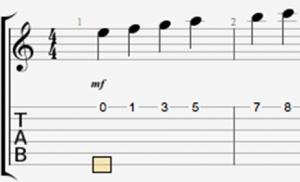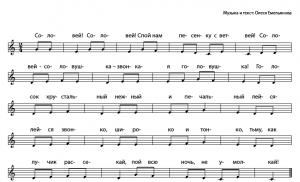"Race for the Galaxy": a guide to the world of the game. Board Game Fight for the Galaxy
It’s not in vain that the inscription “Cult board game” flaunts on the box. " Fight for the Galaxy»/Race for the Galaxy has won many awards since its release in 2007 and has already experienced the second re-release in Russian, which came to our review.
rules
"Struggle for the Galaxy" is a card economic game for 2-4 players in which they compete to build the greatest galactic civilization. Players use one deck for all, in which Worlds and Improvements are involved. At the same time, cards can be used in different ways: as part of your empire, as goods, or as currency. In the process, each player tries to score as many victory points as possible: they are formed by consuming goods, with the help of certain developments, they are brought by some cards of Worlds and Improvements simply by the fact of being in the empire. The Galactic Race ends when someone collects 12 cards in front of them or removes the last Victory Point token from the table, and the player with the most points wins.
How is the extraction of valuable victory points?
There are five phases in the Scramble for the Galaxy board game: Study allows you to draw additional cards from the deck, during Developments you can pay and implement a useful ability, in the phase Development you can add new worlds to your sector (by paying or attacking), in the phase consumption goods can be exchanged for cards or victory points, and Production adds new goods to the corresponding worlds.
But the peculiarity of the game is that not all phases will necessarily recoup. At the beginning of the round, each player secretly chooses one of the actions, then everyone is revealed and those phases for which at least one action was chosen are played in order. At the same time, the phase is mandatory for everyone, but players who choose it consciously will receive a certain bonus.
After that, the players discard excess cards from their hand, and a new round begins. 
Impression
You will not take the game with a swoop. From the first time the rules are a bit difficult to understand. The cards don't make life easy either, at least in the beginning: almost no text on them, just numbers, circles, colors, weird symbols. It's scary for a beginner, to be honest. Checked. But after a few games, the opposite helps - a quick glance at the card is enough to understand its function and possibilities. And this is also verified.
Like so much in Scramble for the Galaxy, the game's world is extremely abstract. As such, there is no plot: certain empires, rebels, aliens without any explanation and artistic descriptions. Illustrations provide some food for fantasy flight, since they occupy the main part of the cards. The work done by artist Mirko Suzuki is very reminiscent of the covers of sci-fi books of the 70s, in places it looks ridiculous, but charming enough and allows you to fill the life / background of the game a little. Perhaps this is at the mercy of the players, after all, the game is focused on economic and strategic aspects.
Actually, the essence of the game is to build the right strategy for collecting victory points: Worlds, Improvements and Developments require serious resources, you won’t be able to buy everything and you will have to clearly understand what is better to focus on in this moment. And this should also be taken into account: thanks to the element of chance, the situation can change every round.
At the same time, there is almost no interaction between players in the game. Of course, they compete with each other for the speed of creating an empire, indirectly influence through the phases (their presence or absence), but it is impossible to really influence the actions of other players, their resources or Worlds (by the way, as it was in "").
The board game contains 5 home world cards, 109 world and development cards, 36 action cards, 4 rulebooks (very useful), and 28 victory point tokens (various sizes and denominations of 1, 5, and 10 points). Cards are thin and can wear out during play, you might want to consider projectors.
In the original, three add-ons were released at the time, which added new maps, a solo mode, an increase in the party to six players, the ability to capture other people's worlds and new ways to win. But they did not come out in Russian, and at the moment it is not known whether they will appear, meanwhile the basic set is being reprinted for the second time. At the same time, the “backs” of Russian cards are made with a localized logo. As you understand, if you want to find and buy add-ons in English somewhere, combining them with the Russian base can be a problem.
Verdict
The game is not easy, in any case, mastery will not come from the first game, it requires a thoughtful approach. "Fight for the Galaxy" is not casual, but serious economic simulator in the shell of space science fiction, and that's what the game is good for. Recommended for seasoned players and those who are hungry for more.

There is no unity in space, and there is no peace in it! As soon as several terrestrial colonies opened a jump drive, they immediately broke into a race for arms, economy and technology. They did not fight directly with each other. But here the competition between them broke out serious. Every colony wants to become the largest, most prosperous and technologically advanced. But not everyone will succeed, that's for sure.
Fight for the Galaxy - card game, which models the competition of galactic civilizations in the fields of economics, science and war. It can be played by two to four players. Each of them becomes the leader of their colony, and tries to lead it to victory. The winner is determined by the number of Victory Points that players receive for conquered worlds, built upgrades, consumed goods, and more.
What does the game actually look like?
There are two types of cards in the main deck: worlds and upgrades. In different ways, they fall into the hands of the players. And then they can be laid out on the table, paying with the remaining cards from your hand. For example, if the planet has a price of 2 (in a large circle), then laying it out, you must also discard two cards from your hand. But there are military worlds that do not surrender to enemies for money. To acquire them, you need to have sufficient military power. You can get it from other planets and upgrades like Space Marines. But improvements, by the way, are always purchased for a fee.
All cards, with rare exceptions, bring victory points, the number of which is indicated in the hexagon next to the price.

How are the cards different?
The worlds are accumulating, producing and, let's say, not connected with the turnover. At the same time, there are 4 different product, which they can store and reproduce, namely: alien innovations, genes, minerals and technologies. The latter means not simple little things of your neighbors in the galaxy, but objects of a disappeared super-civilization. Buying, say, the Abandoned Alien Lab will cost a pretty penny. But if it works, it will easily pay off all the costs.
Producing planets (green - genes, blue - innovations, yellow - alien technologies).
What exactly are the goods for?
And they are needed for consumption and trade. Consumption is the process of exchanging created wealth for abstract victory points. It must be assumed that they reflect the contentment and prosperity of your race. And one of the ways to win is to create effective mechanism receiving these points. Part of the worlds should produce goods, and the other part of the planets and improvements will consume them. Trade is the exchange of goods for cards in hand. The exchange rate depends on the goods and on the special properties of the planets and improvements. By default, the cheapest goods are innovations, and the most expensive are alien technologies. As you remember, cards in hand are a universal means of paying for worlds and improvements. Therefore, often The best way to save up for a heavenly planet - selling some piece of alien hardware on the all-galactic market.
War planets. Some of them are also industrial.
What are the benefits of improvements?
Upgrades are somewhat like planets, but never store or produce goods. However, they can consume goods, increase trade income, reduce the cost of colonizing planets, and many other things. In principle, there are funds for all occasions. But stand out among them upgrades worth six. That's a big price to pay, but not only do these upgrades have useful abilities, they also reward certain strategies with victory points. For example, the Galactic Federation seriously reduces the cost of upgrades and adds victory points for them. The Mining League gives points for planets and mineral upgrades. And what the Alien Institute of Technology values is clear from the name.
Upgrades costing six (Miner League second, Institute fourth, Federation sixth).
It should be noted that several such improvements can be built or not a single one can be built. The player always has a lot of freedom in choosing how to win. A militarist, a merchant, and a skilled production worker can win. What is important is not which way to go to victory, but how effectively this will be done. Moreover, it is impossible to go in cycles in one chosen path. The cards in the hands of the players come randomly. And this means that you need to be able to change the strategy right in the course of the game. I would like to make war, but do the producing planets go into the hand? So why not switch to production? Maybe it will come in handy later in the war.
By the way, it is no coincidence that the original game is called Race for the Galaxy or literally "Race for the Galaxy", and not, say, "War for the Galaxy". This is because the players do not directly collide here. Instead, they compete to build the most efficient schemes victory (scoring). And who is more successful in this - he won.
The interaction here is present only at the step of selecting Actions. At the start of their turn, players secretly choose an Action they would like to take that round. The list is: Search, Improvement, Development, Consumption, Trade and Production. For example, if three players have chosen Exploration, Improvement and Production, then ALL players will be able to introduce an improvement on this turn, develop the planet and start production.
Accordingly, when making a decision, it is possible and necessary to predict the choice of others. After all, action opens up opportunities for everyone.
Set of action cards. Every player has.
Despite such limited interaction, the game remains very interesting and intense. The fact is that there are countless winning combinations and the parties never resemble one another. And a certain element of luck in dealing cards ensures that the game doesn't get too boring or predictable along the way.
By and large, the Fight for the Galaxy has only one serious drawback - it is rather difficult to master.. The player is required to know the pictograms on the cards, represent the proportions of certain cards in the deck, and understand the basic strategies for winning. And all this cannot be learned in one or two games. But somewhere after 5-10 played games, players already begin to navigate the cards and act effectively.
And here the main advantages of the Struggle for the Galaxy appear - high replayability and fascination. And for this, she can be forgiven for difficulties in mastering, and weak interaction, and a rather abstract game universe.
The fight for the Galaxy is sometimes called solitaire. Indeed, in fact it is a complex collective solitaire. But how fascinating is he!
Humanity settled on many planets, which then went their own ways of development. Someone developed industry, someone culture and art, someone tourism ... Someone "took the warpath", and someone undertook to improve human nature through genetic experiments. Gradually, people no longer had enough space, but then the hyperdrive was invented, and each world that had developed by that time began its policy of galactic colonization.
In its process, artifacts and planets of ancient galactic races were discovered. The discoverers studied them and put them to their service. were made and own discoveries both genetic and technological. Naturally, this led to the fact that the activity of humanity that entered the galactic expanse increased dramatically. Entire empires appeared - and, of course, there were those who were dissatisfied with these empires!
Political ambitions, combined with technological growth, have led to strained relations between the galactic states that were once a unified humanity. The explosive expansion has led to the fact that even the whole Galaxy began to seem small. started border conflicts, some of which were overtly political in nature and some were simple raider seizures for purely predatory reasons...
Game history
"Fight for the Galaxy": original and Russian edition, as well as three additions
After the hype of the board game "Puerto Rico"(happened in 2002) it was decided to release its card version. It was supposed to be based on the mechanics of choosing roles, each of which gave some bonus to the player who chose it.
Projects for such a game were developed by several designers, and the final preference was rather predictably given to the version from Andreas Seifert (the author of "Puerto Rico"), which went into circulation under the name "San Juan"(2004). And this whole story could have remained an insignificant episode of the board game business if Thomas Lehmann, a little-known and not very successful author, did not participate in it.
Although his project was rejected, Tom did not lose heart. Taking some ideas from him, he combined them with his older ideas from "Battle for the Stars" ("Duel for the Stars" is a space-themed collectible card game that Lehmann developed in the 1990s, which was also not published). So was born Race for the Galaxy, released in 2007 ... and turned out to be noticeably more successful "San Juan"!
In the next three years, three additions to the game were released, and Tom ceased to be little-known and not very successful. 2009 was marked by two notable events: the game was localized (under the name "Fight for the Galaxy"), and the publisher Rio Grande Games gave official permission for the release of a computer version of the game using the original design.
The essence of the game
As it is easy to understand from the game legend, we are talking about the construction by several players of their own galactic states. Everyone starts with a single starting world, which gives an advantage in one area or another.
The old Earth, for example, has long ceased to produce something and has turned into a kind of mixture shopping center and the galactic exchange. The warlike inhabitants of New Sparta do not like to work or trade, but they are great specialists in the military field. The population of the system, whose star is about to turn into a supernova, volunteers will help to colonize any planet suitable for life, regardless of any effort and cost ...
The game has two types of maps, which are divided into worlds and technologies. These names are somewhat arbitrary: for example, a giant warship of the Ancient Races is quite suitable for settlement and belongs to the worlds, and both organizations (at least the Institute for the Study of the same Ancient Races) and individual specialists (for example, a diplomat-negotiator) are considered technologies.
In turn, among the worlds you can find planets with production capacities and resource reserves. What they produce or extract can be sold and / or spent on various needs of the state. Provided, of course, that the state has trade opportunities or these very needs.
Some cards - both worlds and technologies - carry keywords, denoting their relationship to certain realities common in science fiction: TERRAFORMING(transformation of the planets), UPLIFT(hello from David Brinn and his famous Ascension series) IMPERIUM/REBEL(imperials and rebels - well, how can you not remember « Star Wars» ?) etc. Such maps can interact with each other according to the laws of the genre: the imperials are at war with the rebels, genetically bred soldiers help fight, mining is facilitated on the transformed planets...

In general, the interaction of cards and their effects is the basis of the game. It can be very complex (especially when using extensions)... but it's not enough to play the cards on the table - you still need to make the built chains of effects work!
The life cycle of galactic states consists of several phases - up to six (more precisely, five and a half) in each round. Each player himself chooses what he needs at the moment, takes the appropriate card from a special set, and puts it in the middle of the table. After everyone has made their choice, the cards are turned over and the phases that will be played this time are revealed.
Key Point: All unlocked phases will have a place for all players (with one exception, more on that below), but each player will have a small bonus to their chosen phase. Let's see what features and bonuses there are (the phases always work in the specified order, their names from the official localization are in brackets):
- EXPLORE(“search”) - getting cards into your hand. Two bonuses are possible for the player who has chosen: either search deeper, or keep more for himself.
- DEVELOP("Improvement") - drawing technology cards on the table. The player who chooses plays cheaper.
- SETTLE("development") - a draw on the table of world cards. The player who chooses at the end of the phase draws a card from the deck. Military worlds are a special case: to master them, you need to have the appropriate military power (“onslaught”) ... and when playing with add-ons, you can try to conquer a foreign world!
- TRADE("trade") - strictly speaking, is not a separate phase. It is played only by those who choose it. Each such player can sell one of his resources for several cards. The remaining resources (if any) are consumed (see next phase).
- CONSUME("consumption") - players exchange their available resources for victory points and cards. The exchange is made according to the possibilities that the cards previously played on the table provide them. The player who chooses gets more victory points.
- PRODUCE("production") - on worlds with production capabilities, there are resources available for sale and consumption. The chosen player can "find minerals" on one of his worlds.
It is important to remember that any of the cards played on the table can change the conditions for wagering any of the phases for its owner! For example, there are cards that allow you to sell more. There are cards that allow you to "improve" cheaper ... well, and so on.
The game ends when at least one of two conditions is met: either someone has played 12 or more cards on their table, or the “victory points bank” has been emptied (its size depends on the number of players). Points - both scored by consuming special tokens, and indicated on cards played - determine the winner.
When only two people are playing, it's easier to track your opponent's moves. Therefore, for two, a special version of the duel game is provided, which is more complicated than the usual one: on each turn, you can declare not one phase, but two at once. Properly acting and adjusting to the actions of others, you can develop very quickly! If there are more than two players, then keeping track of everyone, of course, becomes problematic. But, on the other hand, more players means more declared phases, so the dynamics of the game do not suffer.
It should be noted that used in Race for the Galaxy cards carry a lot of conditional pictograms showing bonuses to game phases. Their abundance and variety can scare away a beginner, but you should not panic: the notation is thought out extremely well and is learned very quickly. Non-standard effects are also duplicated by text.
base game

The basis of the game (actually, Race for the Galaxy, localized in 2009) is designed for 2-4 players and is the best way to get acquainted and learn. Of all the options that can be built with add-ons, "base" is the least controversial (if that word is appropriate here) and the most, let's say, simple.
But for getting to know the game mechanics, the base is perfect. There are all the possibilities for building and operating chains of effects, and the symbols on the maps cover almost all conceivable situations in the game, so they can be mastered and used to them without any problems.
The foundation is all the more good for learning because some of the included cards are specifically labeled as "training starter kits". Give them to beginners - and the first two or three moves will be quite obvious; for these moves, beginners will more or less get used to the gameplay, and then you can continue for real.
You can and should immediately notice that add-ons to the game cannot be used without basic set. They only expand the game, but do not allow you to build a game set from scratch. Note also that at the moment none of the add-ons has been localized yet.
First addition. "The Gathering Storm"

Translating the name of this add-on is not so easy. In its basic sense, it means a storm about to break out, but there is also some hint of a second meaning - a sharp increase in grasping activity. On Russian sites (online stores, etc.), the first add-on is most often mentioned under the name "The clouds are gathering".
It quite accurately conveys the idea: according to the gaming legend, humanity has not yet reached military conflicts, but it is already actively starting to prepare for them. Sharply intensify production capacity, who work for the arms race, and the artifacts and technologies of the Ancient Races discovered during research are being attracted with might and main for military purposes. In the political arena, the newly-minted galactic states begin to measure their ratings...
The main innovation is in the game goals. The set includes several tokens, from which a certain subset is selected before the start of the game. These tokens announce tasks for the players, and completing each one is worth victory points.
Tasks are divided into two categories: "priorities" and "excellence". The former require you to do something before all other players (for example, to be the first to gain bonuses to all game phases); the second proposes to have something in quantities larger than others (for example, more than all - and at least four - producing worlds). The “superiority” token, by the way, can be transferred to another player if he surpassed the current owner in the required indicator!
Of course, the add-on contains new cards that lead game process according to the legend. Also in the box you can find additional starting worlds and phase selection cards that make it possible to play with five people, blank cards for implementing your own ideas, and - most unusual - a set of materials for a solo game against a “robot” with a clever and cleverly arranged algorithm of actions (description which occupies a large part of the rules booklet).
Second addition. "Rebel vs Imperium"

Mankind is taking the next step in its galactic evolution: individual rulers have increased appetites and imperial ambitions. In response, "freedom fighters" appear ... and looking at all this, some people are also not averse to snatching a planet or two from their neighbor. There would be an appropriate army.
The main innovation of the second addition is captures, allowing you to appropriate a foreign world. True, there are still few predatory cards (only three, one of which is one-use - military conflicts are still rare), but this possibility can already decide the outcome of the game. Especially if the capture is done correctly, so that if successful, one of the game goals will be fulfilled.
It is still possible to stay away from conflicts. It is enough not to get involved with either the Empire or the rebels (i.e., do not play the appropriate cards on the table) and not get into an arms race (i.e., maintain your military power at zero or negative). You can even play with prohibited captures (in the rules, the author recommends applying such a ban once in every second game). But in general, this addition gives the game a pronounced aggressive character, and lovers of peaceful coexistence will most likely not like it.
If you are a fan of aggression, then especially for you, the rules offer the scenario "Rebels against the Empire." It is played with two players, with each player representing one of the opposing sides. Starting worlds are set accordingly initially, and imperial and rebel aggression cards are added to the initial distribution. Further quote: “Captures are allowed. Good luck to you!"
As military power becomes very significant factor, the add-on kit includes scoring rulers, on which each player can put it aside with special markers: it is desirable that everyone can see who is how strong.

The bundle also includes cards for a sixth player (although playing with six players is already a dubious idea), new objective tokens, materials for adapting solo play ... and, of course, additional cards.
By the way, the increase in the deck (and it becomes noticeably thicker with two additions) led to a small addition to the rules. Now, at the beginning of the game, everyone gets not one starting world, but two: military and civilian. Looking at the cards that came into your hand, you need to choose one of them and keep, and discard the other.
The second addition can be used in the absence of the first, although the author does not recommend this - you will have to abandon the game with goals.
Third addition. The Brink of War

"On the Edge of War"... it is here, according to the game legend, that humanity is located in the third expansion. Tom Lehmann himself wrote that he imagined a situation roughly corresponding to the autumn-winter of 1939: the great powers were solving their political problems with might and main, and Europe was already blazing local conflicts... but the newspapers talked about a "strange war" and no one - almost no one - realized that this was the beginning of a world war.
Yes, conflicts are still local in nature, and there are not so many of them - but there are already more, noticeably more than before! If earlier aggressive maps allowed only military worlds to be captured, now civilian planets can also be subjected to aggression. If earlier only rebels and imperials allowed themselves to capture alien planets, now any galactic ruler with a strong army can try to pursue such a policy. Finally, if earlier it was aggressors who captured other people's worlds, now there are technologies that allow them to be ruthlessly destroyed. Yes, yes, the game has the most real star Of death!
On the other hand, there are also opposite trends in the political arena: in the third addition, it is possible to build your strategy on a negative military power, and even block other people's captures - moreover, directed against any player.
But the most important innovation is a new game resource called galactic prestige. Here it is easiest to give the floor to the author:
“Prestige is something like the comparative authority of individual players' empires and is earned either by playing special cards on the table or through certain abilities as the game progresses. With the help of other abilities, prestige can be turned into the possibility of capturing other people's worlds, obtaining certain benefits, or simply converting it into hand cards and / or victory points. In addition, prestige in each round gives a bonus to the player with the most prestige, and at the end of the game it is converted 1:1 into victory points.
By the way, the symbols of prestige on the cards appeared in the previous addition - then the rules suggested ignoring them for the time being.
Each player is now entitled to a special "super card". Using it, he can either get a “super bonus” to one of the phases, or look through the deck in search of the card he needs (in total, nine categories of cards are available for such a “deep search” to choose from) ... but this can only be done once in the entire game . As you can see, the author is aware of the problem of deck growth and provides players with a means of dealing with it.
Accordingly, the set includes tokens for playing with prestige, new game objectives, materials for expanding the solo game, "super cards" for players and new game cards (including several starter worlds with extremely interesting features!).
To use the third addition, both previous ones are required - this time it is stated categorically and without any reservations.
Gaming accessories

It is strongly recommended that at least the phase selection cards that each player is entitled to wear in the protectors - they are constantly picked up, moved around and placed on the table. One set per player includes nine cards (seven are always needed, two are required only in duel play), and one more is added by the third expansion.
All cards are 63x88mm, the standard size for most collectible card games.
The base game contains 150 cards (114 main ones, including 5 starting worlds; in addition, 4 sets of 9 cards for four players). The first expansion contains 49 cards (1 replacement; 22 playable, including 4 starting worlds; a set of 9 cards for the fifth player; 17 blank cards). The second expansion contains 54 cards (1 replacement; 44 playable, including 3 starting worlds; a set of 9 cards for the sixth player). The third expansion contains 55 cards (1 replacement; 48 playable, including 4 starting worlds; 6 single-use cards for six players).
Some people prefer to count victory points at the very end of the game, and some people like to keep score right during the game (in order to constantly see the leaders and the laggards - this is not prohibited by the rules). If you are one of the latter, then you will need some kind of device such as a counting track with chips according to the number of players.
A complete game set with cards dressed in protectors is conveniently and comfortably placed in the box of any of the add-ons, which is very practical when carrying.
Computer incarnation

Keldon Jones wrote the PC version of the game, which was officially approved by the publisher. Rio Grande Games, although she does not wear official status. The game is distributed free of charge and is available for download at .
The current (at the moment) version 0.7.5 implements all three additions, it has both a game against artificial intelligence and against live opponents over the network (a connection to the server is required, the game "via LAN" is not possible).
Keep in mind that artificial intelligence is very strong, and it is very difficult to beat him. Unfortunately, there are no settings for the difficulty level yet.
This board strategy, which will allow players to take control of an entire space empire. By producing goods and developing their army, conquering and trading, players will develop and improve their galactic states, striving to become the most powerful and influential people in the observable universe.
The unique card mechanics of the Scramble for the Galaxy board game allows players to decide the order and turn order themselves. Despite its thoughtfulness and elaboration, the complex rules of this game can raise a number of questions from novice players.
Especially for the happy owners of the new Russian-language edition of the board game "Fight for the Galaxy", the Unicorn online store has prepared a translation of a small official FAQ (collection of answers to frequently asked questions).
1. How many victory points do you need to use?
12 victory points per player, which are collected in a common pool (24 victory points for two players, 36 for three, and so on).
2. Do I get victory point tokens when I play an Upgrade or a World?
No. Players receive victory point tokens only during the Consume phase.
3. What happens when you run out of victory point tokens?
In this case, 10 victory points must be added to the general pool, and then the Consume phase and the rest of the turn must be completed. After that, the game ends and the winner is determined.
4. What happens when multiple players choose the same phase using a card?
The phase is played only once, but all players who choose it receive their bonuses.
5. What happens during the Explore phase if a player has two "Keep 1 card" abilities?
Such a situation is impossible. Only Science Labs has this ability, and players are limited by the same upgrade rule.
6. Should the player place an item on the gray world?
No. The gray worlds in the Scramble for the Galaxy board game cannot store goods (though they are still useful).
7. What is the player's starting strength in ?
0 plus the bonus from the starting world (from 0 to 2).

8. Why is there a small red circle on some Worlds?
These are Rebel Worlds, which is relevant to some of the cards in the Scramble for the Galaxy board game.
9. Do my trading abilities stack during the "Consume: Trade" phase?
10. Is it possible to use the "consumer" ability of the card to another World?
11. How many goods can be sold per ability?
Only one. If you have more goods than Worlds that can consume them, then unsold goods remain in their places.
12. If I have no cards in my hand at the start of the Consume phase, can I first draw a card as an ability and only then use an ability that causes me to discard a card?

Yes. The abilities of the Consume phase may be played in any order.
We hope that this memo will help you avoid controversial and conflict situations! Table game Fight for the Galaxy is great economic strategy and we would like to more people could enjoy it.
Play with pleasure!
As for the All-Galactic Census, as we usually do, she ate a lot of money and did not tell anyone anything new - except for the fact that for every inhabitant of the Galaxy there are an average of 2.4 legs and 1 domesticated hyena. Since this is clearly not true, the results of the census were out of harm's way sent to the wastebasket.
Douglas Adams, The Hitchhiker's Guide to the Galaxy
Long ago, in a galaxy far, far away... there was a race of cosmic proportions.
Several terrestrial colonies decided to compete for dominance over the Galaxy. But there was no talk of war between them. Who will have time for it when there are so many unexplored worlds and so many unexplored technologies around? You can still defeat the alien fleet, or recapture peace from the rebels there, but to fight with civilizations - no, no! They decided to go to galactic dominance in a different way: through high production rates, advanced developments and satisfaction of all conceivable needs of the population.
Starry sky maps


The contents in the box are nothing at all: a common deck of cards, four decks of phases, and victory point tokens. However, these components add up to a complex and interesting gameplay.
Each player starts their career as a commander of one of the Earth's colonies. Which one is determined by the map of the starting world. In addition, all have an identical set of phases and a small margin random cards in hand. By placing cards representing upgrades and planets on the table and drawing new cards from the deck, the player must earn as many victory points as possible. The cards, being laid out, do not lie passively on the table, but become part of a single mechanism: they perform various tricky functions and actively interact, bringing even more points and cards.
It turns out a kind of collective solitaire on a space theme and with very tricky rules. Each player builds the Greatest Galactic Empire (Federation, Republic - underline as necessary) on his part of the table and is not able to influence others directly. If someone puts the twelfth card on the table or takes the last victory point token, then the game is already one step away from the end. One more move - and victory points will be counted. Whoever has more of them will be the winner.
Often, being late with the withdrawal of one card is enough to miss the victory from the hands. This is the race for the galaxy.
     |
Peaceful expansion...
Don't buy into the poor translation of the name in localization, it's really a race, not a struggle. The lack of direct interaction and the emphasis on self-development does not make the game boring, because it has a phase system.
Each player at the beginning of the turn sets aside one of the phase cards “blindly”, choosing from six main types:
Search- Players take several cards from the deck and keep one for themselves.
Improvement- everyone can introduce one improvement at a time.
Development- everyone can enter one planet.
Trade— one good from the planet can be exchanged for cards.
Consumption- All goods are exchanged for victory point tokens.
Production Planets produce goods, of which there are four types.
When the players make their choice, the phases are simultaneously revealed and form the current turn. For all players it will consist only from those phases that were opened. At the same time, everyone gets a plus in the phase that they have chosen. For example, larger assortment cards when searching, a discount in the improvement phase and double return from consumption. This moment is the most interesting - after all, it is in it that the players interact. They may try to choose those phases that will bring the least benefit to others.
You can and should choose your phase based on what others are supposed to choose. And finally, aerobatics: do not choose the phase that is expected of you, and thereby spoil the strategy for those who are waiting.
What makes the game interesting is also the abundance of paths to victory.
High production and consumption;
Active conquest of "neutral" worlds;
Narrow specialization (for example, on improvements);
Reliance on expensive upgrades that bring a variable number of victory points.
The latter have a list of conditions, the fulfillment of which gives victory points. For example, the Galactic Empire brings them for the conquered worlds of the rebels. And, since the cards come randomly, it is unlikely to collect a complete set for any one strategy. Therefore, the paths of victory are usually combined. In general, to win, relying on single useful cards, not easy. Their successful combinations bring success. Very often, several cards in a bunch can bring much more benefit than a dozen out of order.
     |
Unexplored arms of the galaxy
Or rather, additions to the game, not yet localized in Russia:
RftG: The Gathering Storm- added a single player mode, a battle with an AI algorithm and materials for the fifth player. The most significant innovation is cards for development tasks and priorities for which all players can compete.
RftG: Rebel vs. Imperium- added materials for the sixth player, expanded the stock of development tasks and priorities. The most interesting innovation - there were maps capture worlds from other players. They do not change the balance much, but they make the game more intense and interesting.
RftG: The Brink of War– points mechanic introduced prestige. most prestigious empire is given plus every turn, in addition, points allow you to perform some additional actions. Old mechanics have been expanded. For example, it became possible not only to capture, but also to destroy planets in the style of the Death Star.
... under the muzzles of ship guns


The game is good, not without reason the largest foreign site about board games boardgamegeek.com ranked it twelfth out of more than six thousand games he has rated. There is an exciting gameplay, a wealth of opportunities, the uniqueness of each game, the compactness of game components, and good illustrations. There is an atmosphere of cosmic development. True, it is somewhat spoiled by weak localization, where many terms are translated without understanding the context. For example, the translation of the term " Uplift" how " dawn” is clearly unsuccessful, since it means biotechnological assistance from a highly developed civilization, and not independent progress at all, as one might think from the translation.
The game has one serious minus - it is quite difficult to master. The first reason for this is the use of mostly pictograms instead of text on maps. In fact, they are very informative and convenient, but first they need to remember and comprehend everything. The first few games for a beginner are played in the dark. It is not clear what effect this or that card gives, how it combines with others, and what can be done with it at all.
The second reason is that there are a lot of possibilities in the game, among which it is easy to get confused. The game has cheat sheets where all the phases, icons and many card properties are described, but they do not always help. You should be mentally prepared for the fact that the first games will be difficult.
However, after the rules and cards are studied, and the pictograms are memorized, an interesting and unbanal game will open before the players. Everything here is decided not so much by luck and the talent to annoy the enemy, but by the ability to correctly prioritize, combine dissimilar effects and fast reconfigure your strategy in accordance with changes in the situation. Simply put, four players are guaranteed many hours of interesting and smart pastime!













